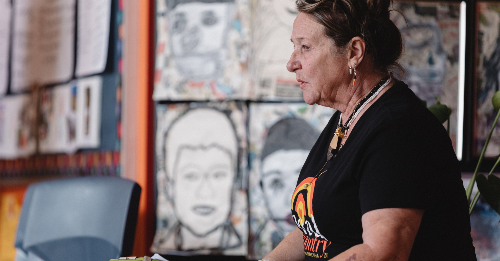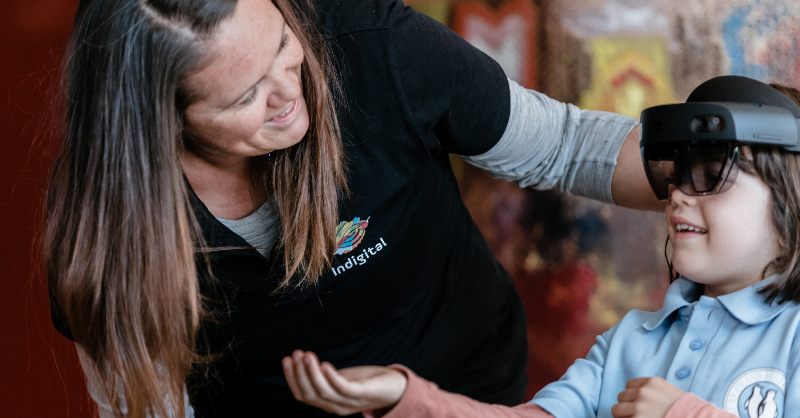By Ashley McPherson | 28 Jan, 2022
In this article, McPherson discusses the Reggio Emilia educational philosophy, which is a student-centred and self-guided curriculum for early childhood and primary-aged students. The focus of the philosophy is on building relationships, self-direction, and experimental learning, and is guided by respect, responsibility and community through exploration, discovery and play.

When I consider the philosophy that underpins Reggio Emilia, I'm drawn back to founder Loris Malaguzzi and the concept of The Hundred Languages. I am now more aware of the various ways in which children demonstrate their understanding, share their thinking and I am more deliberate with my invitations to explore concepts in different ways.
‘As human being[s], children possess a hundred languages, a hundred ways of thinking, of expressing themselves, of understanding, and of encountering others, with a way of thinking that creates connections between the various dimensions of experience rather than separating them. The hundred languages are a metaphor for the extraordinary potentials of children, their knowledge-building and creative processes, the myriad of forms with which life is manifested and knowledge is constructed’ (lstituzione of the Municipality of Reggio Emilia. 2010, p. 10).
If we truly believe this about children sharing their knowledge and thinking in a hundred ways, then we need to look at all available opportunities to enable communication and connection and courageously try those that may be new. We need to listen and engage with student voices, student interests and provide provocations that enable meaningful, deep learning and reflection.
In 2020, students at Bruny Island District school entered the NAIDOC Minecraft Education Challenge and with their entry, we won a prize worth almost $12,000. We won this by responding to the question: How might we build sustainable schools, cities, towns or communities in 2030 using Indigenous science, technology, engineering, arts and maths?
To explore this question in depth, our educators invited the Tasmanian Department of Education Project Officer for Inclusive Curriculum, Palawa man Todd Sculthorpe, to share his rich Aboriginal perspectives and understandings with us. Todd provided our students with a rich learning experience to understand the way his ancestors used science, technology, engineering, arts and mathematics as researchers, problem solvers and communicators.
One of the unexpected outcomes from this challenge and the rich authentic learning from Todd, was the strong sense of identity and connection our students had to learning about the history of our Indigenous peoples and the wonderings they now had about their lives, their way of living and the strong connection they formed to country. The various overlapping of Australian Curriculum content was one part of this inquiry that was extraordinary, but it was the various methods with which our students demonstrated their learning and new understanding that was equally as exciting to see unfold.
Our prize included the face-to-face delivery of an Indigital Schools program, including teacher training, access to software and a three-day workshop led by Indigital Schools, an experience we have just recently had and one we will never forget.
Indigital’s mission is to close the digital divide between Indigenous people and non-Indigenous peoples by providing a meaningful pathway for Indigenous people into the digital economy and the creation of future technologies.
Our week with Indigital Schools started with an invitation to Aboriginal Palawa Elder, Aunty Julie Dunlop and welcoming back Palawa man Todd Sculthorpe, who shared a creation story of Palawa. They recounted the life and story of local Aboriginal Tasmanian women, Truganini of the Nuenonne people who lived on Bruny Island. The creation story was raw, detailed and inspired our students to consider a time that was different to that which they know today.
Todd has since reflected on his time at Bruny Island District School, and he has shared this reflection with us:
‘Being involved with Bruny Island District School in this experience and having the opportunity to involve other Aboriginal Community has been amazing. The students and team from Indigital were so respectful in working with our collective history, culture and country. Whilst the students were tasked with “researching” Tasmanian Aboriginal history and culture, their adaptability in to learning from an Aboriginal perspective, to sit on country, to yarn and most importantly to listen was evident from start to finish. Their questions were well thought out and their designs within augmented reality were respectful of the lessons and stories they were taught. For myself, it has taken my approach towards cultural education to a new level as I further look at ways to bridge cultural knowledge with future digital technologies.’
As educators, we were privileged to have this experience and to then observe the many ways in which the children responded. We witnessed various emotions shared from the students and in various ways. They were deeply engaged with the conversations and stories that were shared, amazed and excited by the possibilities that this new technology offered them, and deeply concerned about our past with many questions they wish to have answered.
The creation story of Palawa had awoken different responses and wonderings for all the children. Some used their voice to share their wonderings, some were deep in thought and others needed to share their thinking with others. Our students reflected deeply about their learning because it was authentic, relevant to their home, their Island and about the history of this place they call home. One student said ‘I’ve learnt a lot about what Bruny Island used to be and what they (Aboriginal people of lu na wanni) did to survive’. Another said, ‘It’s quite important to know our past and what happened. It’s a very good way to learn ... it’s a fun way to learn’. During this learning experience we have had many of our families share with us that their children were sharing the knowledge they had gained from this inquiry over dinner conversations and wanting to engage their families with this experience.
What happened next was unexpected, inspiring, and created an environment of self-discovery, empowerment and connection.

With the support of Indigital Schools, our students demonstrated their connection to these stories using digital technology. They were invited to select a key aspect of the stories that resonated with them and create this as 2D images. Students were given a short tutorial about how to do this work, but by working in collaboration with each other, they quickly discovered many interesting and exciting ways to develop their characters. From the action of collaboration and listening to each other, our students were discovering how this technology could record their thinking and understanding in new and interesting ways.
‘The hundred languages are understood as having the potential to be transformed and multiplied in the cooperation and interaction between the languages, among the children, and between children and adults’ (lstituzione of the Municipality of Reggio Emilia. 2010, p. 10).
Sergio Spaggiari (1994) reminds us, ‘to listen is an active verb; it is not just taking information in, it is also about interpreting the messages, trying to make sense and meaning, making connections, and constructing and co-constructing understanding’ (Millikan, 2003, p.120). The role of the educator at this point was to observe, question, and provide just enough support to keep the learning moving but also to enable the students to be problem-solvers and architects of their own learning. We were observing the learner dispositions of being: thinkers, collaborators, self-managers, researchers and communicators in real life and intertwined together through this learning.
The inquiry then continued as the 2D images were developed further as 3D objects and with the use of the Indigital AR (augmented reality) app, the 3D characters were suddenly placed within our environment through the lens of an Apple or Android device. You can see an overview of the full program on the Indigital Schools website.
In the video, teacher Rory Hamilton comments: ‘I suppose it puts you [the adult] in their [the children’s] world really. They don’t necessarily know what we know but they have to go along with things [that we know]. This is a time to kind of walk in their shoes.’
For the first time, our students had been given an opportunity to engage with technology that combines their learning experience with the current world around them. They were inspired by the ‘gamification’ of the learning and shared both their new knowledge and new digital skills with each other.
Once the AR character was ready, a simple QR code could be shared with family and friends to then place this character into their current world through the lens of a device. With the camera open, the immediate environment is visible but within it is the character the children had created. This technology also has the capability of sound recording therefore enabling features that could embed speeches, comments, or natural sounds into the AR experience.
What made these AR aspects of the story so inspiring were the stories attached to them and the reflections our students made because of this learning experience. With a simple tap on the character within augmented reality, our students could hear the voice recordings they had made to explain their learning, their wonderings or to pose questions to make others consider the impact this knowledge has for them.
When I think about the learning journey our students have had, I can see evidence of the new learning our students have absorbed, the various interpretations they have made of it and the many ways in which they have responded to it.
This technology, with the Indigital AR app, empowers information sharing and knowledge building like never before. With a simple QR code in any location, we can develop and share information using AR technology to engage and inspire others. When reflecting on this learning experience and the way our students engaged in such a rich inquiry, I am confident that we have created an environment for children to express themselves as communicators and to construct their understandings in collaboration with others.
Rory Hamilton, teacher at Bruny Island District School adds: ‘The most interesting thing has been the adverse response I received from some people about using Minecraft. The contrast between the level of engagement and how this technology enabled students to confidently demonstrate their learning in contrast to the parent perception has been really interesting. As an educator, you have to show courage to listen and provide these opportunities to students, even in the face of adverse perceptions or resistance.’
’If children's capabilities are recognised, and they are given opportunity for authentic learning experiences, social and emotional behaviours also change demonstrating tenacity and resilience, and an appreciation of the role of others, both adults and peers, in their search for meaning’ (Millikan, p.46, 2003).
The potential for this is endless. We are currently in a reflective phase and taking the time to deeply consider the learning that has happened and what potential lines of inquiry we could now consider for future learning. With this experience, we are reminded to not limit ourselves to paper and pen recording methods and to explore ways of embedding technology as a tool for demonstrating understanding.
References
lstituzione of the Municipality of Reggio Emilia. (2010). Indications: Preschools and Infant toddler Centres of the Municipality of Reggio Emilia. lstituzione of the Municipality of Reggio Emilia.
Millikan, J. (2003). Reflections: Reggio Emilia Principles Within Australian Contexts. Pademelon Press.
Images supplied by Bruny Island District School, and used here with permission.